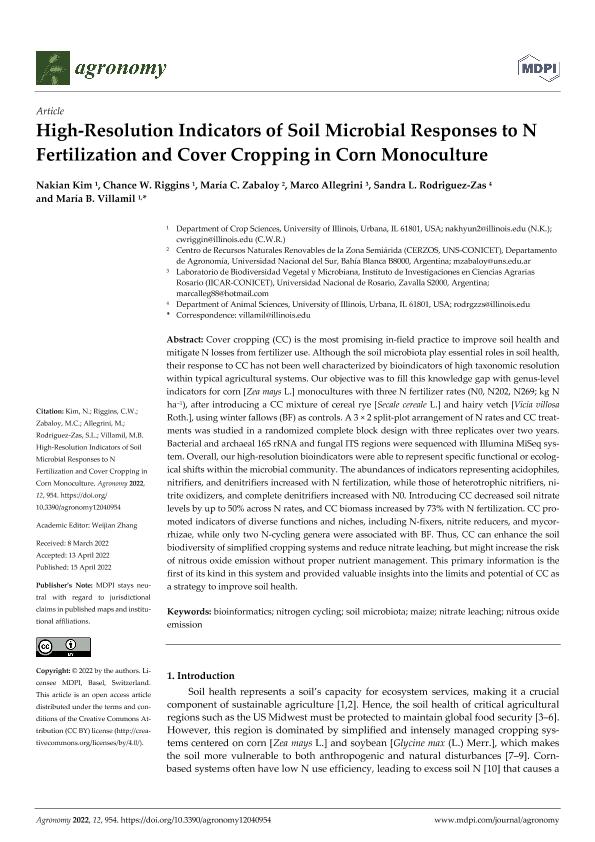Mostrar el registro sencillo del ítem
dc.contributor.author
Kim, Nakian
dc.contributor.author
Riggins, Chance W.
dc.contributor.author
Zabaloy, Maria Celina

dc.contributor.author
Allegrini, Marco

dc.contributor.author
Rodriguez Zas, Sandra L.
dc.contributor.author
Villamil, Maria Bonita

dc.date.available
2023-05-10T16:04:22Z
dc.date.issued
2022-04-15
dc.identifier.citation
Kim, Nakian; Riggins, Chance W.; Zabaloy, Maria Celina; Allegrini, Marco; Rodriguez Zas, Sandra L.; et al.; High-Resolution Indicators of Soil Microbial Responses to N Fertilization and Cover Cropping in Corn Monoculture; MDPI; Agronomy; 12; 4; 15-4-2022; 1-26
dc.identifier.uri
http://hdl.handle.net/11336/197040
dc.description.abstract
Cover cropping (CC) is the most promising in-field practice to improve soil health and mitigate N losses from fertilizer use. Although the soil microbiota play essential roles in soil health, their response to CC has not been well characterized by bioindicators of high taxonomic resolution within typical agricultural systems. Our objective was to fill this knowledge gap with genus-level indicators for corn [Zea mays L.] monocultures with three N fertilizer rates (N0, N202, N269; kg N ha−1), after introducing a CC mixture of cereal rye [Secale cereale L.] and hairy vetch [Vicia villosa Roth.], using winter fallows (BF) as controls. A 3 × 2 split-plot arrangement of N rates and CC treatments was studied in a randomized complete block design with three replicates over two years. Bacterial and archaeal 16S rRNA and fungal ITS regions were sequenced with Illumina MiSeq system. Overall, our high-resolution bioindicators were able to represent specific functional or ecological shifts within the microbial community. The abundances of indicators representing acidophiles, nitrifiers, and denitrifiers increased with N fertilization, while those of heterotrophic nitrifiers, nitrite oxidizers, and complete denitrifiers increased with N0. Introducing CC decreased soil nitrate levels by up to 50% across N rates, and CC biomass increased by 73% with N fertilization. CC promoted indicators of diverse functions and niches, including N-fixers, nitrite reducers, and mycorrhizae, while only two N-cycling genera were associated with BF. Thus, CC can enhance the soil biodiversity of simplified cropping systems and reduce nitrate leaching, but might increase the risk of nitrous oxide emission without proper nutrient management. This primary information is the first of its kind in this system and provided valuable insights into the limits and potential of CC as a strategy to improve soil health.
dc.format
application/pdf
dc.language.iso
eng
dc.publisher
MDPI
dc.rights
info:eu-repo/semantics/openAccess
dc.rights.uri
https://creativecommons.org/licenses/by/2.5/ar/
dc.subject
BIOINFORMATICS
dc.subject
MAIZE
dc.subject
NITRATE LEACHING
dc.subject
NITROGEN CYCLING
dc.subject
NITROUS OXIDE EMISSION
dc.subject
SOIL MICROBIOTA
dc.subject.classification
Biología Celular, Microbiología

dc.subject.classification
Ciencias Biológicas

dc.subject.classification
CIENCIAS NATURALES Y EXACTAS

dc.subject.classification
Ciencias del Suelo

dc.subject.classification
Agricultura, Silvicultura y Pesca

dc.subject.classification
CIENCIAS AGRÍCOLAS

dc.title
High-Resolution Indicators of Soil Microbial Responses to N Fertilization and Cover Cropping in Corn Monoculture
dc.type
info:eu-repo/semantics/article
dc.type
info:ar-repo/semantics/artículo
dc.type
info:eu-repo/semantics/publishedVersion
dc.date.updated
2023-04-27T18:30:30Z
dc.identifier.eissn
2073-4395
dc.journal.volume
12
dc.journal.number
4
dc.journal.pagination
1-26
dc.journal.pais
Suiza

dc.description.fil
Fil: Kim, Nakian. University of Illinois at Urbana; Estados Unidos
dc.description.fil
Fil: Riggins, Chance W.. University of Illinois at Urbana; Estados Unidos
dc.description.fil
Fil: Zabaloy, Maria Celina. Consejo Nacional de Investigaciones Científicas y Técnicas. Centro Científico Tecnológico Conicet - Bahía Blanca. Centro de Recursos Naturales Renovables de la Zona Semiárida. Universidad Nacional del Sur. Centro de Recursos Naturales Renovables de la Zona Semiárida; Argentina. Universidad Nacional del Sur. Departamento de Agronomía; Argentina
dc.description.fil
Fil: Allegrini, Marco. Consejo Nacional de Investigaciones Científicas y Técnicas. Centro Científico Tecnológico Conicet - Rosario. Instituto de Investigaciones en Ciencias Agrarias de Rosario. Universidad Nacional de Rosario. Facultad de Ciencias Agrarias. Instituto de Investigaciones en Ciencias Agrarias de Rosario; Argentina
dc.description.fil
Fil: Rodriguez Zas, Sandra L.. University of Illinois at Urbana; Estados Unidos
dc.description.fil
Fil: Villamil, Maria Bonita. University of Illinois at Urbana; Estados Unidos
dc.journal.title
Agronomy
dc.relation.alternativeid
info:eu-repo/semantics/altIdentifier/url/https://www.mdpi.com/2073-4395/12/4/954
dc.relation.alternativeid
info:eu-repo/semantics/altIdentifier/doi/http://dx.doi.org/10.3390/agronomy12040954
Archivos asociados
